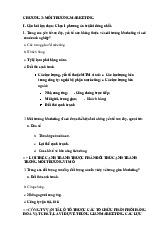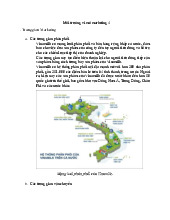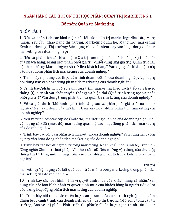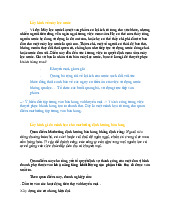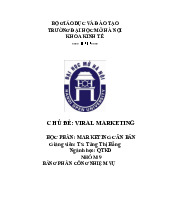



















Preview text:
lOMoAR cPSD| 47708777 10 / 2/2022 Consumer behaviour Dr. Do Khac Xuan Diem Email: diem.dkx@ou.edu.vn 1 1 Learning objectives Chapter 3
Internal influences on consumer
behaviour: The self, personality, lifestyles, values. 2 2 1 lOMoAR cPSD| 47708777 10 / 2/2022
• Objective 1: Explain the main perspective of the self, focusing on
psychological and socially oriented perspectives.
• Objective 2: Understand that products and services consumers use
influence self-esteem and self-image.
• Objective 3: Understand gender identity and roles and their effects on consumption behaviour. 3 3 Learning objectives
• Objective 4: Understand how consumer personality traits influence consumer choices.
• Objective 5: Compare and contrast consumer personality with brand personality.
• Objective 6: Understand how consumer lifestyles influence consumer choices.
• Objective 7: Understand how consumer values influence consumer choices. 4 4 2 lOMoAR cPSD| 47708777 10 / 2/2022 5 Learning objective 1: E
x p l a i n t h e m a i n p e r s p e c t i v e o f t h e s e l f , f o c u s i n g o n p
s y c h o l o g i c a l a n d s o c i a l l y o r i e n t e d p e r s p e c t i v e s . 5 What is the self-concept?
Self-concept summarizes the beliefs a person holds about his own
attributes and how he evaluates the self on these qualities.
- Content (facial attractiveness versus mental aptitude)
- Positivity (i.e. self-esteem) - Intensity and stability
- Accuracy (the degree to which one’s self-assessment corresponds to reality) 6 6 Identity 3 lOMoAR cPSD| 47708777 10 / 2/2022
Identity is defined as ‘any category label with which a consumer
selfassociates that is amenable to a clear picture of what a person in
that category looks like, thinks, feels and does’. 7 7 What is the self-esteem?
Self-esteem refers to the positivity of a person’s self-concept. Social comparison
The perspective that people compare their outcomes with others’
as a way to increase the stability of their own self-evaluation. 8 8 Actual and ideal selves 4 lOMoAR cPSD| 47708777 10 / 2/2022
• Ideal self: our conception of how we would like to be
• Actual self: our more realistic appraisal of the qualities we have. • Products can: Help us reach ideal self
Be consistent with actual self
• Impression management means that we
work to “manage” what others think of us. 9 9 Multiple selves Marketers pitch products needed to facilitate active role identities. 10 10 5 lOMoAR cPSD| 47708777 10 / 2/2022 Self- consciousness • Public self- consciousness A personality trait that makes a person very aware of how they appear to others. • Self-monitors Individuals who are very conscious of their behaviour in social situations. 11 6 lOMoAR cPSD| 47708777 10 / 2/2022 11 12 Learning objective 2: U
n d e r s t a n d t h a t p r o d u c t s a n d s e r v i c e s c o n s u m e r s u
s e i n f l u e n c e s e l f - e s t e e m a n d s e l f - i m a g e . 12 Are we what we buy?
• Self-image congruence models
Approaches based on the prediction
that products will be chosen when
their attributes match some aspect of the self. Product Usage = Self-Image ‘My BMW is my wingman, my twin. I would never diss it for another car because that
• Consumers demonstrate their values
would be like dissing my through their 7 lOMoAR cPSD| 47708777 10 / 2/2022
purchase behavior. twin brother or worse, dissing myself’. 13 13 Are we what we buy?
• Symbolic self-completion theory The
perspective that people who have
an incomplete self-definition in
some contexts will compensate by
acquiring symbols associated with a desired social identity. 14 14 For reflection
Advertising can utilize a consumer’s self-esteem in promoting a
product by offering the product as a remedy to low self-esteem. Self-
esteem advertising: products provide remedy to low self-esteem. 8 lOMoAR cPSD| 47708777 10 / 2/2022
How effective do you think this form of advertising is? 15 15 16 Learning objective 3: U
n d e r s t a n d g e n d e r i d e n t i t y a n d r o l e s a n d t h e i r e
f f e c t s o n c o n s u m p t i o n b e h a v i o u r . 16 9 lOMoAR cPSD| 47708777 10 / 2/2022 G
e n d e r d i f f e r e n c e s i n s o c i a l i s a t i o n
• Gender roles vary by culture but are changing
• Many societies still expect traditional roles: Agentic roles: men are expected to be assertive and have certain skills. Communal roles: women are taught to foster harmonious relationships. 17 17 Sex-typed traits and products • Sex-typed traits
Characteristics that are stereotypically
associated with one gender or the other. • Sex-types products
Products that reflect stereotypical
masculine or feminine attributes. 18 18 10 lOMoAR cPSD| 47708777 10 / 2/2022 S e x u a l i d e n t i t y • Male • Female • Androgyny
• Gay, lesbian, bisexual and transgender (GLBT) 19 19 For reflection
• What are two examples of sex-typed products?
• Are there situations for which promoting sex-typed products
might limit the market for a product? 20 20 11 lOMoAR cPSD| 47708777 10 / 2/2022 21 Learning objective 4: U
n d e r s t a n d h o w c o n s u m e r p e r s o n a l i t y t r a i t s i
n f l u e n c e c o n s u m e r c h o i c e s . 21 What is personality Personality
A person’s unique psychological make-up,
which consistently influences the way the person Are we born with personality? responds to his or her environment. • Psychodynamic approach • Developmental approach • Nature – nurture debate 22 22
Psychodynamic theories: Freudian theory 12 lOMoAR cPSD| 47708777 10 / 2/2022 ID Ego Superego The system The system The system
oriented that mediates towards that between the immediate id internalizes and the gratification. society’s rules superego. and prevents the id from seeking selfish gratification. 23 23 Motivational research 24 24 Neo-Freudian theories 13 lOMoAR cPSD| 47708777 10 / 2/2022 • Karen Horney
Compliant versus detached versus aggressive • Alfred Adler Motivation to overcome
inferiority • Harry Stack Sullivan Personality evolves to reduce anxiety • Carl Jung
Developed analytical psychology
Established concept of collective unconscious Creation of archetypes 25 25 Trait theory
Personality traits: identifiable characteristics that define a person.
Traits relevant to consumer behavior: • Innovativeness • Materialism • Self-consciousness • Need for cognition • Need for uniqueness • Introversion/extroversion • Frugality 26 26
The Big Five Personality Traits 14 lOMoAR cPSD| 47708777 10 / 2/2022 27 27
The Myers-Briggs Type Indicator (MBTI) 28 28
The influence of personality traits on consumer behaviour 15 lOMoAR cPSD| 47708777 10 / 2/2022 29 29 30 Learning objective 5: C
o m p a r e a n d c o n t r a s t c o n s u m e r p e r s o n a l i t y w
i t h b r a n d p e r s o n a l i t y . 30 Brand personality 16 lOMoAR cPSD| 47708777 10 / 2/2022 Brand personality
A set of traits people attribute to a product as if it were a person. “unkind, little
“Shrewd but fair and credibility” empathy, selfish elite” 31 31 Brand personality
• Sincerity: domestic, honest, genuine, cheerful
• Excitement: daring, spirited, imaginative, up-to-date
• Competence: trusted, reliable, dependable, efficient
• Sophistication: glamorous, pretentious, charming, romantic
• Ruggedness : tough, strong, outdoorsy, rugged Rugged, outdoorsy, tough, athletic
Surprising, lively, ‘with it’ Serious, intelligent, Old-fashioned, Glamorous, romantic, efficient wholesome, traditional sexy 32 17 lOMoAR cPSD| 47708777 10 / 2/2022 32
Brand behaviour and possible personality traits inferences Brand Action Trait Inference
Brand is repositioned several times or changes slogan repeatedly Flighty, schizophrenic
Brand uses continuing character in advertising Familiar, comfortable
Brand charges high prices and uses exclusive distribution Snobbish, sophisticated
Brand frequently available on deal Cheap, uncultured
Brand offers many line extensions Versatile, adaptable 33 33 For reflection
1. How does your personality influence what you buy or what brand you choose?
2. How can marketers link a brand’s personality with the lifestyle of a consumer segment? 34 34
Lifestyles and consumer identity 18 lOMoAR cPSD| 47708777 10 / 2/2022 35 Learning objective 6: U
n d e r s t a n d h o w c o n s u m e r l i f e s t y l e s i n f l u e n c e c
o n s u m e r c h o i c e s . 35
Lifestyle defines a pattern of consumption that reflects a person’s choices of how to spend his/her time and money. 36 36
Lifestyle marketing perspective 19 lOMoAR cPSD| 47708777 10 / 2/2022 Consumption style 37 37
Product complementarity and co-branding strategies 20
